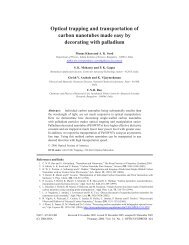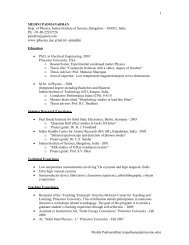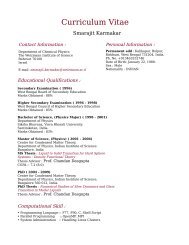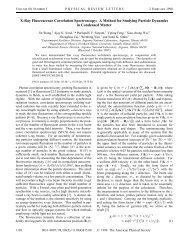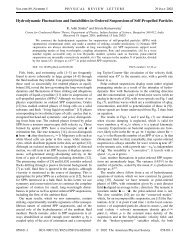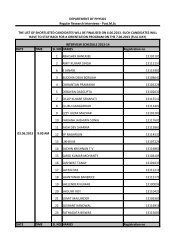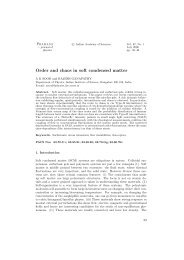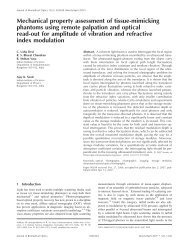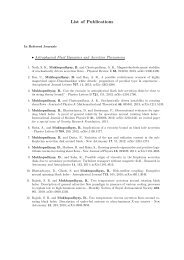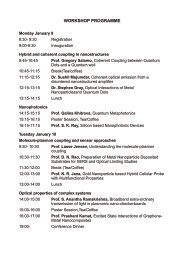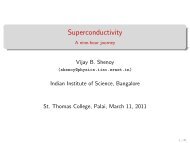Thermoelectric Properties of Fe0.2Co3.8Sb12-xTex ... - Physics
Thermoelectric Properties of Fe0.2Co3.8Sb12-xTex ... - Physics
Thermoelectric Properties of Fe0.2Co3.8Sb12-xTex ... - Physics
You also want an ePaper? Increase the reach of your titles
YUMPU automatically turns print PDFs into web optimized ePapers that Google loves.
Bio – sensors based on electrical and optical properties <strong>of</strong><br />
Carbon nanotubes & Graphene oxide<br />
K. S. Vasu a , S. Sridevi b , S. Asokan b , N. Jayaraman c and A. K. Sood a<br />
a Department <strong>of</strong> <strong>Physics</strong>, Indian Institute <strong>of</strong> Science, Bangalore<br />
b Department <strong>of</strong> Instrumentation and Applied <strong>Physics</strong>, Indian Institute <strong>of</strong> Science, Bangalore<br />
c Department <strong>of</strong> Organic Chemistry, Indian Institute <strong>of</strong> Science, Bangalore.<br />
We show that single walled carbon nanotubes (SWNTs) decorated with sugar functionalized<br />
poly (propyl ether imine) (PETIM) dendrimer (DM) is a very sensitive platform to quantitatively<br />
detect carbohydrate recognizing proteins, namely, lectins. The mannose attached PETIM<br />
dendrimers undergo charge – transfer interactions with the SWNT. The changes in the<br />
conductance <strong>of</strong> the dendritic sugar functionalized SWNT after addition <strong>of</strong> lectins in varying<br />
concentrations were found to follow the Langmuir type isotherm, giving the concanavalin A<br />
(Con A) – mannose affinity constant to be 8.5 x 10 6 M -1 [1].<br />
We have recently shown that etched Fiber Bragg Gratings (eFBGs) coated with nano – carbon<br />
materials can be used as potential biochemical sensors. The shift in the Bragg wavelength (∆λ B )<br />
with respect to the λ B values <strong>of</strong> SWNT (or GO) – DM coated eFBG for various concentrations <strong>of</strong><br />
lectin follows Langmuir type adsorption isotherm and quantitatively analyzed to establish the<br />
detection limit [2].<br />
References:<br />
1) K. S. Vasu, K. Naresh, R. S. Bagul, N. Jayaraman and A. K. Sood, Appl. Phys. Lett. 101,<br />
053701 (2012).<br />
2) S. Sridevi, K.S. Vasu, N. Jayaraman, S. Asokan and A.K. Sood (2013).



